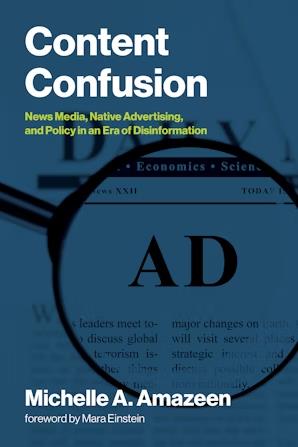
New Book Asks: Article or Ad?
A Q&A with COM’s Michelle Amazeen

Michelle Amazeen has dedicated her research to exploring mis- and disinformation in order to build awareness around it and combat it. An associate professor of Mass Communication, associate dean of research and the director of the Communication Research Center at COM, she contributed to The Debunking Handbook 2020, which compiled research and advice around quashing misinformation, as well as The COVID-19 Vaccine Communication Handbook, an online guide to fight misinformation about COVID-19 vaccines. Amazeen has now published Content Confusion: News Media, Native Advertising, and Policy in an Era of Disinformation (MIT Press, 2025), in which she delves into how industries and corporations—including the fossil fuel industry—are influencing public thought through native advertising—ads masked as editorial content.
“This certainly isn’t something that the news outlets themselves will cover in any sort of meaningful way,” says Amazeen. “I wanted to take this opportunity to connect all the dots, add new scholarship and empirical data, and try and help people understand what’s happening with our media system.”
COMtalk spoke with Amazeen about her new book, the rise of native advertising, and its implications on society.
Q&A
COMtalk spoke with Amazeen about her new book
COMtalk: You argue that native advertising is a genre of disinformation. How so?
Michelle Amazeen: I call it disinformation, meaning that there is intent to deceive—as opposed to misinformation, where there is no intent. I argue that native advertising is inherently disinformation, because by its very nature, it is intended to appear to be something that is not. It is camouflaged to appear to be editorial content rather than commercial content, and that is because it is believed that people would be more likely to read and or engage with the material if they thought it was editorial content. Many people are averse to engaging with commercial content.
COMtalk: But you found that’s not the case.
Michelle Amazeen: Readers do care. There actually is evidence that people do very much care about being deceived. They don’t like it.
COMtalk: Why did you choose to focus on native advertising by news outlets in this book?
Michelle Amazeen: I wanted to make people aware that this is happening, that these aren’t ads that an external group is buying space for and then placing. No, this content is being created by the news organizations themselves, and sometimes the content that’s in these ads directly contradicts what’s coming out of the newsrooms of these news organizations. So, in a way, these news organizations are being complicit and misleading audiences about certain consequential topics, especially if we’re focusing on things like climate change or energy consumption or health matters.
COMtalk: Did you find that there are any particular sectors that are major players when it comes to participating in native advertising?
Michelle Amazeen: A former T Brand Studio [the branded storytelling unit of the New York Times] insider who worked there and became disillusioned and left told me that the main sectors tend to be deep-pocketed industries. Native ads are very expensive to purchase, so I believe the fossil fuel energy industry, the financial industry and technology are the top three.
COMtalk: When did native advertising gain prominence? What contributed to its rise?
Michelle Amazeen: Native advertising is actually a contemporary evolution of what used to be called advertorials or reading notices, which appeared in print media going back as far as the 1800s. It was formalized in the 1950s at The Atlantic and in the early 1970s, when the New York Times and the Washington Post came out with advertorials in their editorial sections.
But what I mostly focus on in my book is the digital progeny of advertorials, which emerged around 2013 or so, with the launch of the in-house content studios at the New York Times, Washington Post, and, soon thereafter, the Wall Street Journal. Initially, these news organizations wanted nothing to do with native advertising. They thought it was not within journalistic standards or not ethical. But a few influential people started pushing the boundaries. Once one of them started blurring the lines on this and generating revenue, which was the primary driver for all this, it became a thing that almost all of them are now doing.
COMtalk: You mentioned earlier that native advertising is camouflaged to appear to be editorial content. How does some native advertising fool even the most digital savvy among us?
Michelle Amazeen: Well, some of them don’t have any disclosure [that it’s an ad], which is illegal, but how do you enforce that? The Federal Trade Commission is the enforcer, and they just don’t have the bandwidth to be holding all these news outlets accountable. They’re supposed to have a disclosure on there, but there’s no standardization on what the disclosure needs to say, what it looks like, how prominent it is, and so news orgs have done all sorts of gymnastic contortions to try and make the disclosures less visible. They’re often tiny or they’re grayed out so that they don’t stand out against the background. And sometimes they’re over to one side and you don’t even know what it’s connected to on the screen. Sometimes the language isn’t obvious; for example, “paid post”—not everybody knows what that means.
COMtalk: Did you conduct any experiments to see if people were able to discern whether something was native advertising?
Michelle Amazeen: I did many experiments to see how people perceived the ads. We found over and over again that most people didn’t understand [that it was an ad]—either they didn’t see the disclosures or didn’t know what they meant. And it wasn’t just my research that indicated this. There have been many other scholars who have done similar studies and came to the same conclusion.
COMtalk: In what ways has native advertising impacted society?
Michelle Amazeen: I think it’s harmed our trust in the institution of journalism. There have been many times when I’m looking at something and I don’t feel good about what it is. I can’t tell what it is. And so you start looking at all news with some skepticism—is this really news or is it an ad? This hasn’t happened in a vacuum—the infotainment of news has been an even longer slide over the years.
And even if you don’t come across a native ad firsthand, you may come across it on social media. Somebody shares what seems like an article about what a fossil fuel company is doing, how they’re becoming more sustainable. And if you think that’s coming from the New York Times rather than from Exxon Mobil, you’ll interpret the information a little bit differently. You’ll be more receptive to it, perhaps.
When we have the fossil fuel industry setting the narrative, talking about how renewables are unreliable and that natural gas is clean, they’re influencing how consumers respond in the marketplace. They’re influencing policymakers and the types of policies they put forward, and that has implications for what’s happening to the earth.
COMtalk: How has it impacted those within the journalism industry?
Michelle Amazeen: It impacts the journalists themselves, but it has also impacted the journalism, the content. I’ll start with the latter: There’s been more than one study that has come to the conclusion that when news outlets engage in the practice of native advertising, their coverage of those advertisers tends to soften, and some of it is out of fear of antagonizing a company that’s paying the bills. In the book, I report on a study I did with one of my collaborators, Chris Vargo. We did a big data analysis where we looked at thousands of native ads that ran in the New York Times, Washington Post and Wall Street Journal across a five-year period. These ads were from Fortune 1,000 companies, and we found that after a native ad ran in a news outlet, half the time there was less reporting coming out of the newsroom about that company. That was just one study. I’d love to see more research on this.
Then there are also the effects that this practice has on the journalists themselves. In the book, I talk about how it’s very demoralizing to many journalists. I spoke to several journalists who conceded that, yeah, “I’ve been told that we have this advertiser and that I need to change some things in my article,” or to be careful not to upset this advertiser. There have been journalists who have quit or resigned because they thought it was an affront to their readers that this was happening. Probably one of the most prominent journalists that this affected in the United States was Jill Abramson, who was the executive editor at the New York Times. She was pushed out, in part, because she thought this was a bad practice and wouldn’t go along with it. As it turns out, Jill is going to interview me on December 4. BU’s Institute for Global Sustainability is hosting a book talk for me and Jill is going to be there moderating. I’m excited to talk to her about this practice.



